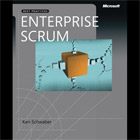The two best things about this book are that it: (1) provides a framework for adopting Scrum across an enterprise, and (2) describes some techniques for surmounting some of the problems you will likely face as you try. Although the book is about the "enterprise and Scrum" most of the contents will be applicable to any group of teams transitioning to Scrum. A set of five teams working together on a single project would benefit from this book even if they are not the whole enterprise.
Too many agile books suffer from being targeted at a single team working on a deserted island—that is, a seven-person team with no issues outside their one team. This book does not suffer from that problem. Want to know how to organize work on a project that is partitioned by architectural layer? How to structure a product backlog for the entire organization? Or how to organize teams across a large project? Or what are the proper reporting relationships on a large Scrum project? This book provides sage advice on these enterprise adoption issues and more.
The book is chock-full of real-life anecdotes (in which only the name of the company and key players have been changed). Each anecdote illustrates how one real company dealt with a real problem. Their problem, their context, and their solution won’t exactly be yours, but seeing how others have addressed challenges can be illuminating in thinking how to address yours.
This is probably not your best choice as a first book on Scrum. For that start with the author’s other two books. This book picks up where they left off, providing a wealth of information for enterprises and even workgroups adopting Scrum. If you’re already familiar with the basics of Scrum, and especially if you are starting to hit the hard points of adopting it and spreading it through your organization then this book is for you.







